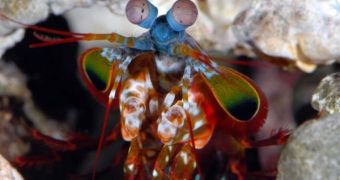It's a widely known fact that humans use only three colors to make out the environment around them, and those are red, green and blue. While we have evolved to a point where we can make good use of our limited capabilities, and are proud of it, the mantis shrimp is way in front of us, in terms of performances. The sea creature is capable of making out 12 basic colors and can also see various types of polarized light, which is something that we cannot do at all. Its vision range spans from the near-infrared to the ultraviolet wavelengths, LiveScience reports.
The mantis shrimp, which is usually found on the coasts of Australia, is, in fact, the most visually advanced animal known to science. Experts believe that its abilities could provide the foundation necessary for a completely new DVD technology, one that could copy the most essential parts of the sea creature's abilities. The most important one is the ability to detect polarized light. That is to say, specially developed cells inside the retinas are able to pick up linearly polarized light and convert it into circularly polarized light. The opposite process can also be accomplished.
In human-made devices, such as CDs, DVDs, and camera sensors, polarized light is detected via devices known as quarter-wave plates, but these instruments only tend to work on a single color. In the mantis shrimps, the “plates” function across the whole visible light spectrum, and, naturally, all the colors it contains. It can also detect polarized light in the near-infrared and ultraviolet wavelengths.
“Our work reveals for the first time the unique design and mechanism of the quarter-wave plate in the mantis shrimp's eye. It really is exceptional – out-performing anything we humans have so far been able to create,” scientist Nicholas Roberts explains. He is a research expert at the University of Bristol, and also the lead author of a new paper detailing the finds, published in the latest issue of the respected scientific journal Nature Photonics. According to the expert, it may be that the mantis shrimp uses its polarized light-detection abilities to gain a clearer view of the prey while underwater.
“What's particularly exciting is how beautifully simple it is. This natural mechanism, comprised of cell membranes rolled into tubes, completely outperforms synthetic designs. It could help us make better optical devices in the future using liquid crystals that have been chemically engineered to mimic the properties of the cells in the mantis shrimp's eye,” the expert concludes.

 14 DAY TRIAL //
14 DAY TRIAL //